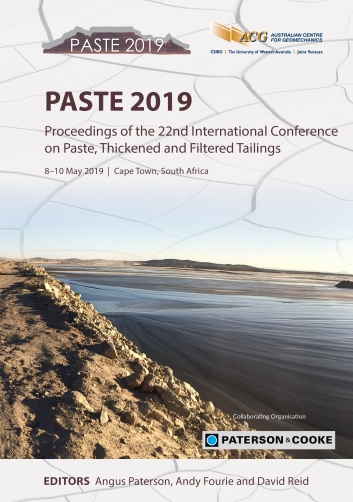Tailings dewatering with increased filtration rates and lowest filter cake moisture for filtered tailings stacking

|
Authors: Hahn, J |
DOI https://doi.org/10.36487/ACG_rep/1910_16_Hahn
Cite As:
Hahn, J 2019, 'Tailings dewatering with increased filtration rates and lowest filter cake moisture for filtered tailings stacking', in AJC Paterson, AB Fourie & D Reid (eds), Paste 2019: Proceedings of the 22nd International Conference on Paste, Thickened and Filtered Tailings, Australian Centre for Geomechanics, Perth, pp. 245-257, https://doi.org/10.36487/ACG_rep/1910_16_Hahn
Abstract:
The most commonly used dewatering technologies for the filtration of tailings from ore processing are pressure filters, filter presses, belt filters and rotary vacuum disc filters. The vacuum disc filter type in around 80% of all applications is the most economical of these technologies in terms of capital and operating cost, especially when modern high performance disc filters are used. The Boozer disc filter is a big diameter high performance vacuum disc filter that has set the pattern in a multitude of applications including the alumina industry and in dewatering coal slurries. In the past decade, this type of disc filter has established itself in applications of tailings dewatering, such as tailings from gold/copper, zinc and gold/silver mines. The reasons for its successful operation in tailings dewatering are: (a) high throughput and dewatering performance, (b) operational reliability even in the case of varying feed conditions, (c) simple and robust design, (d) ease of maintenance, (e) a small footprint. To achieve higher solids throughput rates, or to achieve the lowest possible filter cake moisture, HiBar filtration and HiBar steam pressure filtration offer new solutions in tailings dewatering. HiBar filtration and the HiBar steam pressure filtration are advanced continuous pressure filtration processes realised on rotary disc filters that are installed in a pressure vessel. The application of hyperbaric pressure of up to 6 bar (instead of a vacuum) ensures a high filtration rate and dewatering capability even with filter cakes of fine particles where high cake resistance and capillary forces in the cake must be overcome. With HiBar steam pressure filtration, the use of steam under special conditions improves demoisturing to the furthest extent, leading to the lowest values of moisture content. The drier HiBar filter cake improves the cake handling and disposal with steeper dumping slopes, resulting in reduced disposal area and improved safety of the disposal site.
Keywords: dewatering, vacuum disc filter, continuous pressure filtration, filter cake firmness
References:
Gerl, S & Stahl, W 1996, ‘Improved dewatering of coal by steam pressure filtration’, Coal Preparation, vol. 17, issue 1-2,
pp. 137–146.
Hahn, J, Bott, R, & Langeloh, T 2014a, ‘Economical dewatering of tailings for mine backfill with high performance disc filters’, in Y Potvin & T Grice (eds), Proceedings of the 11th International Symposium on Mining with Backfill, Australian Centre for Geomechanics, Perth, pp. 41–48.
Hahn, J, Bott, R & Langeloh, T 2014b, ‘Successful start-up of first HiBar steam pressure filtration plant for dry bauxite residue (DBR)’, The 32nd International Conference and Exhibition of ICSOBA, The International Committee for Study of Bauxite, Alumina & Aluminium, Quebec.
Hahn, J, Bott, R & Langeloh, T 2015, ‘Size matters, weight too – disc filter design for the future’, Proceedings of the 10th Alumina Quality Workshop, AQW Inc., Eagle Farm.
Hahn, J, Bott, R & Langeloh, T 2016, ‘HiBar steam pressure filtration of coal ultrafines – new developments and results’, in V Litvinenko (ed.), Proceedings of the 16th Australian Coal Preparation Society Conference, Springer, Wollongong.
© Copyright 2025, Australian Centre for Geomechanics (ACG), The University of Western Australia. All rights reserved.
View copyright/legal information
Please direct any queries or error reports to repository-acg@uwa.edu.au
View copyright/legal information
Please direct any queries or error reports to repository-acg@uwa.edu.au


